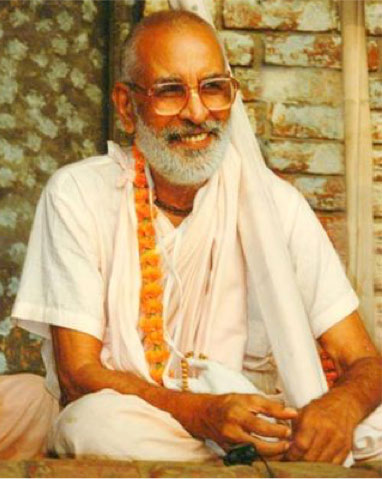sri sri guru gauranga jayatah!

Year 1, Issue 9, Amāvasyā
Speical Edition
Posted: 28 September 2019
Dedicated to and Inspired by
nitya-lila pravista om visnupada
Śrī Śrīmad Bhaktivedānta Nārāyaṇa Gosvāmī Māhārāja
Without Sādhu-saṅga,
One Cannot Perform Bhajana

Śrī Śrī Guru-Gauraṅgau Jayataḥ
Śrī Keśavajī Gauḍīya Maṭha
Mathurā (U.P.)
21 May, 1992
Dear Viṣṇu dāsa
My affectionate blessings. I received your letter. I became pleased to read how beautifully you have expressed your beautiful moods in your beautiful language. Just recently Rāmacandra dāsa and one of his companions (your friend) came here, and they were very happy to know that you have sent me a letter. Rāmacandra dāsa, your parents and brother and sister come here from time to time to see me and hear hari-kathā.
I became more pleased to know that your mind is now good, and you have earned maximum marks in your class. You should not be worried about anything and should focus your mind solely on sādhana-bhajana and your studies. To settle into householder life can be considered later on. If a sādhaka has developed complete detachment from worldly life (saṁsāra), no one can make him attached to worldly life. And someone in whom detachment has not arisen can settle worldly life anywhere he goes.
[In Jaiva-dharma] there is Śrī Vijaya-kumāra and Śrī Brajanātha. Of the two, Brajanātha was an unmarried youth and Śrī Vijaya-kumāra was a married middle-aged person. Both received tattva-jñāna from the same guru. Thereafter, the unmarried youth married, and the married person gave up his household life. That is, Brajanātha got married and Vijaya-kumāra renounced his household life, took paramahaṁsa-veśa (the cloth of a renunciant) and became engaged in performing bhajana of Bhagavān.
The first lesson is that bhajana can be performed in both stages: householder and renounced, but it is very essential that one has access to sādhu-saṅga. In either situation, one cannot perform bhajana without sādhu-saṅga.
Secondly, by performing bhakti, vairāgya (detachment) will certainly appear naturally. This is a customary secondary fruit of performing bhakti. In this way, when one’s bhakti reaches the stage of bhāva, one cannot remain attached to any worldly thing. When the married Brajanātha’s stage of bhāva matures, he will surely attain the fully renounced, paramahaṁsa stage like Vijaya-kumāra, regardless of whether he lives in house or not. Having knowledge (jñāna) and having realized knowledge (vijñāna) are two different things. When Brajanātha’s guru ordered him to enter gṛhastha life, Brajanātha certainly had jñāna, but he did not have the qualification (adhikāra) for renunciation. His gurudeva gave him such an instruction only after considering his qualification.
By performing bhajana in sādhu-saṅga, sambandha-jñāna (knowledge of one’s relationship with Kṛṣṇa) awakens. At first sambandha-jñāna arises with the help of one’s intelligence (buddhi). Thereafter by performing bhajana, anarthas are dispelled and by the mercy of śrī gurudeva, real sambandha-jñāna awakens. At that time, one begins performing bhajana with firm faith. [Gradually] one reaches the stage of ruci (taste) and then one develops āsakti (attachment) to bhajana and to bhajanīya-vastu (the object of bhajana) and one’s mind becomes stable. Although there may be a cause for the mind to become disturbed, it doesn’t. Even a single moment is not wasted by not performing bhagavad-bhajana, and one becomes detached from sense objects. One does not hanker for praise and honour (pratiṣṭha). A strong hope that one will surely attain Kṛṣṇa always exists. An eagerness to attain Kṛṣṇa exists. An exceptional ruci develops for chanting the holy name and performing kīrtana. One becomes fond of having darśana of Bhagavān’s līlā-sthalīs and residing there. An intense desire to serve Vaiṣṇavas exists. One experiences great relish in hearing and speaking hari-kathā. These are some symptoms.
It is essential to chant the gāyatrī, gopāla-mantra, kāma-gāyatrī and other special mantras, with love and devotion. One can chant them somewhat more than what is prescribed for the three sandhyas. For example, they can be chanted 108 times, but japa and kīrtana of the mahā-mantra should indeed be chanted the most.
Rāgātmika-bhakti exists only in the eternal associates of Kṛṣṇa such as Subala, Śrīdāma, Śrī Nanda-Yaśodā, Lalitā and Viśākhā. When, within one’s ātma, anurāga for Kṛṣṇa flows naturally and incessantly, that anurāga rich service is called rāgātmika-bhakti. A fortunate sādhaka of this world may develop a greed in his heart to attain such rāgātmika-bhakti. Therefore, when he performs sādhana-bhajana under the guidance of a rasika uttama mahā-bhāgavata, it is called rāgānuga-bhakti. In other words, when one performs bhajana with rāga (ardent attachment) it is called rāgātmika-bhakti, and when rāga is not present in the heart, the sādhana to attain it is called rāgānuga-bhakti. About gopāla-mantra and kāma-gāyatrī, it is mentioned in Jaiva-dharma. Inform me that you have received this letter. Accept my blessings, full of affection.
Your ever well-wisher,
Śrī Bhaktivedānta Nārāyaṇa